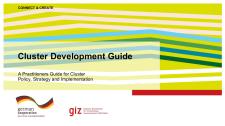
A Practitioners Guide for Cluster Policy, Strategy and Implementation
In economic development policy, the term “cluster” is usually used to describegeographical concentrations of companiesand innovation activities. According to cluster theory, both firms and regions benefit from clusters. “These benefits accrue as a result of co-location or geographic proximity that, in turn, creates lower input costs for firms through agglomeration economies and facilitates knowledge spilloversthat produce innovation and increased productivity.”
Clusters can be understood as both, a development approach aimed at facilitating networking and cooperation between companies and a real economic phenomenon, such as a Cluster management organisation. They play a crucial role in boosting collaboration and networking among companies as well as in building bridges across different ecosystems, enabling innovation among SMEs.
The aim of the present document is to give practitioners comprehensive and recent information on how to best support clusterdevelopment in practice.It incorporates state-of-the-art trends andtakes into accountthe new framework conditions resultingfrom digital transformation and technological convergence. It also considers the new reality of the COVID-19 pandemic andrelated societal changes which give rise to shifts in cluster policies.